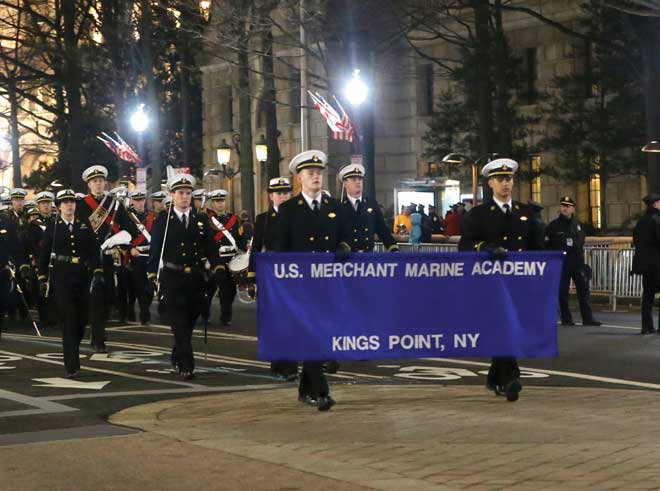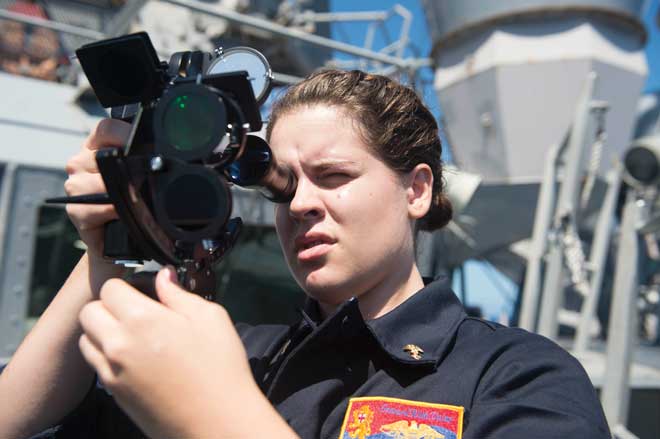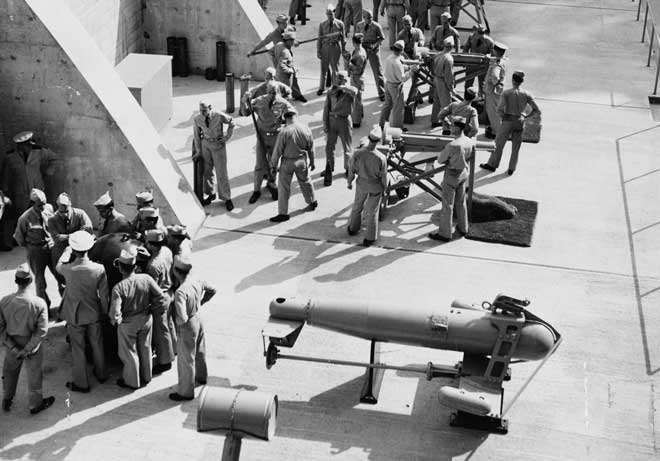
The U.S. Merchant Marine Academy, known colloquially as “Kings Point” for its location in New York, is one of the nation’s five federal service academies. Established during World War II, the academy became permanent in 1956 when Congress amended the Merchant Marine Act of 1936 to “provide for the [academy’s] maintenance.” Today, in spite of a proud history and government declarations to the contrary, the U.S. Merchant Marine Academy appears to have lost its way.
In 2016, the Middle States Commission on Higher Education (MSCHE) placed the academy’s accreditation on warning status after what should have been a routine reaccreditation visit. This is the first time any federal service academy has been at risk of losing its accreditation. The academy was found not to be in compliance with 5 of the commission’s 14 criteria for reaccreditation, plus 1 of its 10 requirements for affiliation with MSCHE.1 Among the many deficiencies listed, most noteworthy was that the superintendent did not have the ability to manage the academy. Equally alarming, the visiting committee found that efforts by the academy’s leadership to deal with sexual harassment and assaults at the Kings Point campus were ineffective and inconsistent and that discipline in general was applied unevenly across the Regiment of Midshipmen by the commandant’s staff.
Thus, alongside all of its proud honors, including being the only federal service academy with a Regimental Battle Standard, Kings Point now has the distinction of being the first federal academy to have its ability to issue academic degrees questioned. Today, although most of the compliance issues have been resolved, the question remains: What caused such a dire situation?
Among the many reasons, three stand out. First, Kings Point is administratively unlike either a civilian university or the other federal service academies. Second, the U.S. Merchant Marine Academy’s governance and management are inefficient and ineffective and have been for years. Third, the academy’s leadership has been disconnected from its stakeholders for more than a decade.

Administrative Status
Unlike the U.S. Military, Air Force, Coast Guard, and Naval academies, the U.S. Merchant Marine Academy is not supported by one of the armed services. Neither does it function in the same way as public state universities or the senior military colleges (The Citadel, for instance) or the six state maritime schools.2
Instead, the U.S. Merchant Marine Academy is an entity of the U.S. Department of Transportation’s Maritime Administration (MarAd), a status that is a relic of its wartime birth. During World War II, Kings Point was established as one of the many training facilities of the U.S. Maritime Service, which functioned as a uniformed service like the other armed services. However, although the military services in the late 1940s remained significantly larger than their prewar establishments, the U.S. Maritime Service essentially had been demolished, its only remaining component the U.S. Merchant Marine Academy. Thus, instead of maintaining a status similar to the other federal academies, Kings Point fell into administrative limbo.
Upon dissolution of the U.S. Maritime Commission, the U.S. Merchant Marine Academy became an entity of MarAd following its creation within the Department of Commerce in 1950. MarAd was transferred to the Department of Transportation in 1981. Although MarAd is officially “charged with maintaining the health of the merchant marine, since commercial mariners, vessels, and intermodal facilities are vital for supporting national security,” as an organization it has spectacularly failed in this responsibility.3
Since 1960, the U.S. Merchant Marine has shrunk from 2,926 oceangoing ships (16.9 percent of the world fleet) to 169 oceangoing ships (0.4 percent of the world fleet).4 Even as recently as 1999, U.S.-flag vessels represented 1.6 percent of the world’s fleet. Shashi Kumar, acting superintendent of the U.S. Merchant Marine Academy on three separate occasions, noted in Proceedings, “The privately owned U.S.-flag fleet is so low in numbers today that there is genuine concern over having sufficient qualified mariners to crew the Ready Reserve Force (RRF) surge sealift fleet in a major contingency exceeding four to six months, i.e., beyond their initial activation.”
As a result, MarAd’s only real day-to-day function other than maintaining the RRF is to operate the U.S. Merchant Marine Academy. In fact, the academy’s fiscal year 2017 budget request of $100 million accounted for more than 60 percent of MarAd’s total request.5
In spite of MarAd’s poor stewardship of Kings Point and the many problems created by it, the academy in the past always compensated through wise governance and skilled leadership. Neither virtue has been readily apparent for at least a decade. This perhaps became publicly most evident in a series of bizarre decisions by three senior leaders: former Maritime Administrator Paul N. Jaenichen (a retired U.S. Navy captain), MarAd Executive Director—and briefly acting Administrator—Joel Szabat (a career civil servant), and Superintendent James A. Helis (a retired U.S. Army colonel). These decisions most notably include the abrupt suspension of “Sea Year” in June 2016 and the eviction of the U.S. Merchant Marine Academy Alumni Association and Foundation from its campus offices in 2013.
Sea Year, a comprehensive at-sea apprenticeship served on active merchant ships, sits at the heart of the academy curriculum. Suspending it has had a clear impact on the ability of several classes of Kings Point midshipmen to complete all graduation requirements, especially acquiring the practical experience required to achieve their U.S. Coast Guard licenses. Kings Point midshipmen cannot receive a degree without also earning the Coast Guard license and a commission; none of these three can be awarded separately.
The decision to interrupt a program that sent Kings Point midshipmen into harm’s way during all U.S. wars since World War II is especially difficult to comprehend given the public rationale for doing so—that Kings Point’s midshipmen were in physical and emotional danger from sexual harassment and assault on board today’s U.S. flag merchant ships.6 Despite this apparent danger, all six state maritime schools took the opportunity to fill seagoing billets vacated by Kings Point midshipmen with their own students. Thus, the state maritime schools, facing the same issues and with the same information as MarAd, made opposite decisions regarding the safety and welfare of their seagoing students.
Although Sea Year resumed this past spring, fewer billets for Kings Point midshipmen are available both as a result of lower voluntary participation by shipping companies and billets being occupied by state maritime school students. MarAd has yet to make clear to any of the academy’s stakeholders the implications of the revised Sea Year on Kings Point’s current and future midshipmen
The peculiar financial and administrative status of the academy is further highlighted by the inexplicable circumstance that, unlike the other federal academies, the U.S. Merchant Marine Academy is the only institution of higher education in the nation that is required by law to close during a congressional budget impasse, as happened most recently in October 2013. This unique status cripples the ability of the U.S. Merchant Marine Academy to achieve the maritime academic excellence that is its mission.

Governance
Evidence of the U.S. Merchant Marine Academy’s ineffective governance and management is immediately visible to campus visitors in the essentially abandoned boathouse with gaping holes in its roof and deck, with no obvious warnings or barriers to keep the unsuspecting from harm. Other signs of deterioration can be seen throughout the academy’s physical plant.
The authority to operate and manage the U.S. Military, Naval, Air Force, and Coast Guard academies is vested in their respective superintendents, who act as chief operating officers. The superintendents are supported and supervised by their service chiefs and largely apolitical senior staffs. These staffs, heavily populated by service academy alumni, function to some degree as a “board of directors,” in that they provide the resources to operate the institution, set policy and strategic direction, hire, fire, and discipline senior administrators—including the superintendent—and generally represent each academy’s stakeholders.
The senior military colleges and state maritime schools have formal, appointed boards responsible for their governance. For example, the Virginia Military Institute (VMI), the nation’s first state-supported military college, is supervised by its board of visitors, which “defines the mission of the Institute as a public institution of higher education in the Commonwealth of Virginia and oversees the development, revision, and implementation of a strategic plan for the accomplishment of that mission.”7
Further, VMI’s board is responsible for all curricular, financial, and staff issues. Like the service staffs that support the federal academies, this board is required to have robust alumni membership (75 percent) to ensure the best interests of the school and its stakeholders are fully represented in an apolitical fashion. The governing boards of similar institutions have similar responsibilities and membership.
However, the U.S. Merchant Marine Academy has no true board of trustees. Instead, all management and governance authority is concentrated in the hands of one person, the politically appointed head of the U.S. Maritime Administration—the Maritime Administrator.8 Though two boards do exist, MarAd’s Maritime Education and Training Executive Review Board and the academy’s Congressional Board of Visitors, both lack authority.
Maritime Administrative Order 150-3 of 19 October 2016 established the Maritime Education and Training Executive Review Board “[to] oversee the governance and management of the United States Merchant Marine Academy,” but board membership consists entirely of MarAd employees who report directly to the Maritime Administrator.9 Further, paragraph 2.03 of the board’s implementing order states the following regarding delegation of authority to it by the Maritime Administrator:
This Delegation of Authority does not include authority to:
1. Commit the expenditure of any funds or execute any contracts, grants or cooperative agreements.
2. Make any determination with respect to employment matters, including hiring, firing, performance review, promotion or discipline of any Academy personnel.
Thus, since the authority to commit funds, execute contracts, and hire/fire/discipline academy personnel remains in the hands of the Maritime Administrator, the “Executive Review Board” has no real authority to govern the U.S. Merchant Marine Academy.
The responsibilities and authority of the Congressional Board of Visitors are similarly limited:
The Board shall inquire into the state of morale and discipline, the curriculum, instruction, physical equipment, fiscal affairs, and academic methods of the Academy, and other matters relating to the Academy that the Board decides to consider.10
Clearly, inquiry is neither supervision nor management authority.
A third body, the U.S. Merchant Marine Academy’s so-called Advisory Board, has even less responsibility or authority.11
It is significant that none of the academy’s “governing” boards has meaningful stakeholder representation, especially representation by academy alumni who are, because of their prevalence in the maritime industry, the U.S. Merchant Marine Academy’s primary stakeholders.
Leadership
The leadership of the academy has been unstable for quite some time. The last Maritime Administrator with any experience or background in the maritime industry outside the U.S. Navy left office on 20 January 2009. Many Maritime Administrators over the past 20 years have been career civil servants with no background in the maritime industry whatsoever.
The current administration took roughly six months after the inauguration to appoint and oversee the confirmation of Maritime Administrator Rear Admiral Mark H. Buzby, U.S. Navy (Retired), which was two months faster than the previous administration. (Admiral Buzby, a career Navy surface warfare officer, is a member of the Kings Point Class of 1979.) Thus, lengthy gaps between appointed Maritime Administrators have become the norm, leaving the official management of the academy in the hands of a MarAd senior career civil servant. Given that the average tenure of MarAd appointees is about three years, even the enlightened leadership of one Maritime Administrator may be quickly undone through bureaucratic inertia or a less enlightened successor.
The academy also has had four superintendents in the past decade, with former Academic Dean Kumar serving as acting superintendent on three separate occasions. The last superintendent with any significant maritime industry background and experience retired in 1993. Only three alumni have served as superintendent in the Academy’s entire history, while two U.S. Coast Guard Academy alumni, one U.S. Naval Academy alumnus, and one U.S. Military Academy alumnus have headed Kings Point since 1970. By comparison, every superintendent of the U.S. Naval Academy since 1881 has been a Naval Academy alumnus.
Further, superintendents of all five service academies historically have been retired flag officers, but two of the most recent Kings Point superintendents retired from their service at pay grade O-6. Finally, it has been a decade or more since the academy’s commandant or a majority of senior staff—who are responsible for military leadership and discipline of the Regiment of Midshipmen—have been either alumni or other academy stakeholders.
Solving the Problem
To ensure its long-term viability, the U.S. Merchant Marine Academy should be chartered as a standalone entity, modeled on the state-owned senior military colleges and maritime schools. To be effective, this must include establishment of a strong, independent governing board.
Such a board must have the authority to oversee the institution and set its course for the future in accordance with its charter and mission. The statutory composition of the board should require that no less than three-fourths of its members be alumni, the majority of whom should either be serving military officers or directly employed in the maritime industry.
The U.S. Merchant Marine Academy’s status and funding must be changed so that midshipmen are no longer sent home because of a budgetary impasse between the President and Congress while the other academies continue to operate.
The sooner these repairs to the Merchant Marine Academy’s foundations are accomplished, the sooner the academy can resume a steady course, and ensure that it continues to provide the nation with the well-trained leaders that its future requires.
1. Middle States Commission on Higher Education, “MSCHE Determination Letter – 24 June 2016,” www.usmma.edu/academics/msche-determination-letter-%E2%80%93-24-june-2016.
2. The senior military colleges are Norwich University, Texas A&M, The Citadel, Virginia Military Institute, Virginia Polytechnic Institute, and University of North Georgia. The state maritime schools are Maine Maritime Academy, Massachusetts Maritime Academy, SUNY-Maritime College, Texas A&M Maritime Academy, California Maritime Academy, and Great Lakes Maritime Academy.
3. U.S. Maritime Administration, “About Us,” www.marad.dot.gov/about-us/.
4. U.S. Department of Transportation, “Transportation Statistics,” rita.dot.gov/bts/sites/rita.dot.gov.bts/files/publications/national_transportation_statistics/html/table_01_24.html_mfd.
5. U.S. Department of Transportation, “Budget Estimates, Fiscal Year 2017 — Maritime Administration,” cms.dot.gov/sites/dot.gov/files/docs/MARAD-FY-2017-CJ.pdf.
6. U.S. Merchant Marine Aacademy Alumni Association and Foundation, “Announcement from the Academy,” www.usmmaaf.com/s/1175/hybrid/social.aspx?sid=1175&gid=1&pgid=1544&cid=3212&ecid=3212&crid=0&calpgid=15&calcid=752.
7. Virginia Military Institute, “Board of Visitors,” www.vmi.edu/about/administration/board-of-visitors/.
8. A Level III presidential appointment, slightly senior in precedence to the Chief of Naval Operations and the other Joint Chiefs of Staff.
9. U.S. Merchant Marine Academy, “Monitoring Report to the MSCHE, Appendix C,” www.kingspointsentry.com/documents/Full%20Monitoring%20Report.pdf.
10. U.S. Merchant Marine Academy, “BOV Statutory Language,” www.usmma.edu/about/leadership/bov-statutory-language.
11. U.S. Merchant Marine Academy, “USMMA Advisory Board,” www.usmma.edu/about/leadership/usmma-advisory-board.


